Where are the single-subject appropriations bills we were promised? That’s the question headlining a September 7 video posted to Rep. Matt Gaetz’s (R-FL) House.gov media page, foreshadowing both the last-minute budget battle, the 45-day continuing resolution (CR) kicking the can down the road, and the removal of Kevin McCarthy (R-CA) as Speaker of the House. Government shutdown, omnibus spending bills, and continuing resolutions – these are the boogeyman buzzwords of the federal funding fight that comes around every year, as reliable as Christmas. Can a single-subject approach really solve America’s spending and debt problems?
Efficient, Effective, and Accountable?
Some of the more hardline members of the House GOP – like Rep. Gaetz, who introduced the motion to vacate Speaker McCarthy ostensibly over broken promises regarding the budget process – have vowed never to vote for a CR. To them, the way to force both sides of the fiscal and political fence to balance the budget is to only vote for single-subject bills and simply refuse to support anything else, no matter the cost. Government shutdown looming? Either pass a balanced budget by way of single-subject appropriations or let it die. It’s the rip-off-the-band-aid approach, if you will.
Though he had to swear allegiance to that cause to get the job, the now former speaker lambasted the approach and abandoned it entirely. “It’s easy to be a conservative who wants to do nothing. But I believe America wants to find a conservative who can make government work efficiently, effectively and accountably,” McCarthy said during a press conference at the Capitol after he advanced the stopgap bill to keep the government running for a mere month and a half. “That’s exactly what we’re doing in the appropriations process.”
Efficient, effective, and accountable? None of those words can describe the federal funding process in Congress today – or, for that matter, over the last few decades. Each year, the House has to pass 12 spending bills to account for the federal government’s discretionary spending. If this isn’t done by October 1, any part of the government not funded by mandatory spending that doesn’t change from year to year runs out of money and shuts down. Or rather, the payroll shuts down. The military, for example, isn’t disbanded – but paychecks do stop.
When the 45-day CR was passed on September 30, only four of those dozen mandatory spending bills had been passed by the House – each completed in the last week of the fiscal year, and none at all passed by the Senate. And this is neither new nor, in itself, particularly newsworthy, sadly. In the almost 50 years since the Congressional Budget and Impoundment Control Act of 1974 established this budgetary process, Congress has passed a complete budget before the deadline only four times: 1977, 1989, 1995, and 1997. And even in those last three years, Congress was late in getting the ball rolling with a budget blueprint, nearly failing even then. In other words, it is almost never the orderly process explained in the 1974 law, but a mix of late budget blueprints, continuing resolutions, and massive omnibus appropriations packages that few if any of the lawmakers voting on them have had the chance to read.
Omnibuses, Riders, and Logrolling, Oh My!
In December of 2022 – already a few months into Fiscal Year 2023 – Congress passed an omnibus spending package that covered all 12 mandatory spending areas. The massive tome was 4,155 pages long and obligated about $1.7 trillion in taxpayer dollars. Is this truly what it takes to keep the government running? Of course not. But what’s an omnibus spending package without a number of hidden riders and a good deal of logrolling?
 A rider is an otherwise unrelated measure attached to a bill – either written in the original legislation or by way of amendment – that passes along with the host law. Because bills aren’t voted on in sections, the only way to kill the rider is to force an amendment that removes it or to kill the whole package. As described by the James Madison Institute, most riders would never pass on their own; naturally, that’s why they’re attached. When it comes to mandatory spending, the host bill provides quite a bit of cover to riders. Wrap a dozen must-pass spending measures into a single omnibus, and now those riders have cover and concealment. Who has time to find all the hidden gems in a 4,000-plus page law?
A rider is an otherwise unrelated measure attached to a bill – either written in the original legislation or by way of amendment – that passes along with the host law. Because bills aren’t voted on in sections, the only way to kill the rider is to force an amendment that removes it or to kill the whole package. As described by the James Madison Institute, most riders would never pass on their own; naturally, that’s why they’re attached. When it comes to mandatory spending, the host bill provides quite a bit of cover to riders. Wrap a dozen must-pass spending measures into a single omnibus, and now those riders have cover and concealment. Who has time to find all the hidden gems in a 4,000-plus page law?
Members of Congress often include these legislative caveats to fund their own pet projects, bring tax money into their districts, and pad the wallets of their lobbyists. But it’s also common for such riders to be offered up to other lawmakers in hopes of convincing them to vote for a bill they might otherwise reject. This practice, commonly known as logrolling, often does prevent a legislative logjam – but it also leads to billions more tax dollars being spent than it really takes to run the nation. And these “Christmas Tree Bills,” as some call them, result in some truly odd and downright ridiculous expenditures.
A Festivus for the Rest of Us – And a Good Reason for Single-Subject Appropriations
Each year, Sen. Rand Paul (R-KY) publishes his Festivus Report, chronicling the waste of government spending. Paul highlighted a whopping $482,276,543,907 worth of waste in his latest report – yes, that’s just shy of half-a-trillion dollars! Billions, of course, was related to COVID-19. But beyond that, we the people spent $192,592 on Starbucks espresso machines for the DOD, $1.7 billion to maintain empty government buildings, $17 million for hotel rooms for illegal immigrants that were never used, $3 million to build a museum to Gandhi, and $2.5 million in Super Bowl commercials reminding us to fill out the Census.

(Photo by Emanuele Cremaschi/Getty Images)
But wait, there’s more. We paid for studies into the social life and collective intelligence of ants, whether kids really love their pets, the racism of mice, and the romantic lives of parrots. We paid to train mice to binge drink alcohol (hopefully just the racist ones), watched hamsters on steroids do battle, and injected six-month-old beagle puppies with cocaine (ah, so that’s how it got in the White House). Perhaps most ridiculously of all, however, more than $100,000 of the money taken from American workers through the legalized extortion racket known as taxation went to researchers at Georgia Tech to study if Thanos – were he a real entity rather than a fictitious character from the Marvel comic and cinematic universe – could in fact actually snap his fingers if he were wearing an Infinity Gauntlet, an also-fictitious device granting him god-like powers.
Is it any wonder, then, that fiscal conservatives demand single-subject appropriation bills? Yes, ideological riders can still be attached to single-subject bills – but they’re much easier to spot, far less likely to include money for dog doping or research into the powers of comic book villains, and killing such poisoned measures doesn’t require shutting down the entire discretionary funding process.




